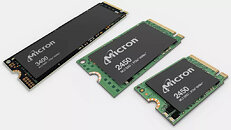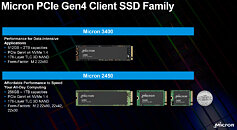Wednesday, June 2nd 2021

Micron Delivers 176-layer NAND and 1α (1-alpha) DRAM Technology
Micron, the US-based manufacturer of various kinds of memory technologies, has today announced some quite interesting products at its Computex 2021 keynote. For starters, the company has announced a new portfolio of products based on 176-layer NAND. There are currently two products listed that use this new technology and those are the Micron 3400 and 2450 M.2 NVMe SSDs. Based on the PCIe 4.0 interface, the 2450 SSD lineup is designed as a value-oriented solution that comes in M.2-2280, M.2-2242, and M.2-2230 sizes. It ranges from 256 GB to 1 TB in capacities, which are supposed to be priced as a value purchase.
In a contrast, the 3400 SSD is M.2-2280 design, meant for only the highest performance. The sequential read speeds go up to 6600 MB/s, while the sequential writes go up to 5000 MB/s (in the case of the 2 TB model). Capacities range from 512 GB to 2 TB and only the 1 TB and 2 TB variants have the 5000 MB/s write speeds, while the 512 GB version is capped at 3600 MB/s speed. Both SSD models are featuring a heat spreader on top of NAND chips and spot an in-house and Micron-developed NVMe 1.4 SSD controller. However, Micron does note that the company is free to use any 3rd party SSD controller as we are deep in component shortages with high demand for SSDs. You can get an in-depth look at the 2450 and 3400 M.2 SSDs from Micron's website.Another big announcement Micron made was the shipment of the world's first 1α-based LPDDR4x and DDR4 memories. The 1α (1-alpha) process is designed to reduce power consumption and increase density. Micron claims that the new process delivers a 40% density increase and up to 20% improvement in power savings. This is no small gain, and if the claims are true, a whole plethora of mobile devices will receive benefits.
Source:
Micron
In a contrast, the 3400 SSD is M.2-2280 design, meant for only the highest performance. The sequential read speeds go up to 6600 MB/s, while the sequential writes go up to 5000 MB/s (in the case of the 2 TB model). Capacities range from 512 GB to 2 TB and only the 1 TB and 2 TB variants have the 5000 MB/s write speeds, while the 512 GB version is capped at 3600 MB/s speed. Both SSD models are featuring a heat spreader on top of NAND chips and spot an in-house and Micron-developed NVMe 1.4 SSD controller. However, Micron does note that the company is free to use any 3rd party SSD controller as we are deep in component shortages with high demand for SSDs. You can get an in-depth look at the 2450 and 3400 M.2 SSDs from Micron's website.Another big announcement Micron made was the shipment of the world's first 1α-based LPDDR4x and DDR4 memories. The 1α (1-alpha) process is designed to reduce power consumption and increase density. Micron claims that the new process delivers a 40% density increase and up to 20% improvement in power savings. This is no small gain, and if the claims are true, a whole plethora of mobile devices will receive benefits.


11 Comments on Micron Delivers 176-layer NAND and 1α (1-alpha) DRAM Technology
Higher iops are more important imho.
They seem to have either experimented a lot or put a lot of trust into this process. It goes by the Z40x Design ID family and I've counted six distinct DDR4 revisions in this new family already. Thaiphoon reports 8Gbit R as made on a 15nm process but it's hard to tell at this point, with all the alphas :D For comparison, family Z30x (16nm) seemed to only have 3 revisions (1 of which is a unicorn), Z20x (17nm) had 5 (1 of which is a unicorn, 1 a highly suspected plain downbin... and 1 is awesome), and their growth wasn't immediate...
It should also be reasonably priced, but we'll have to wait and see about that.
No-one will offer a $200 4TB SSD today, or this year, as prices are expected to go up. However, this NAND is a step on the way there.
You can get a 2TB SATA drive for that today though, possibly even a budget NVMe drive.
I mean, there's a valid point for the manufacturer, profits, capacity and stuff, I just feel unexcited as a consumer.
This allows more NAND per package, but each package costs more, as it has more NAND in it.
But two packages are cheaper than four, for 2TB.
So your logic is flawed in this case.